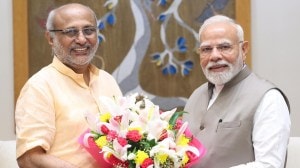When Janiki Dehuri, mother of 10, decided – no more
Janiki does not know her age – her Aadhaar card says she is 42 – the year she got married, the whereabouts of her 18-year-old firstborn or why she was abandoned by her husband for undergoing sterilisation.
 Janiki Dehuri with her children. (Express)
Janiki Dehuri with her children. (Express) “Look at her health. Both the mother and infant are underweight. Did I do something wrong by getting her sterilised without her husband’s knowledge?” said Bijaylaxmi Biswal, a Accredited Social Health Activist (ASHA) worker at Dimiria village, in Odisha’s Keonjhar district, pointing to the frail new mother, Janiki Dehuri.
Bijaylaxmi has been with Janiki through each of her nine deliveries in the past, including a stillbirth, since 2005, and so, when the tenth was born, she finally managed to convince the new mother to go in for a tubectomy.
On February 14, Bijaylaxmi had taken Janiki, who belongs to the Bhuyan tribe, to a sterilisation camp at the Telkoi CHC. When Janiki returned home after the procedure, her 57-year-old husband Rabi Dehuri accused her of being “impure” and did not allow her to enter their thatched-roof house in Dimiria village. For the next three days, Janiki, her newborn and her other children took shelter under a mango tree outside their house. Rabi relented only after the local Bhuyan community leader, health workers and panchayat officials intervened.
Janiki does not know her age – her Aadhaar card says she is 42 – the year she got married, the whereabouts of her 18-year-old firstborn or why she was abandoned by her husband for undergoing sterilisation.
Wearing a moss green saree, her month-old infant fast asleep in her lap, Janiki said, “I didn’t want any more children after my third delivery, but he (Rabi) was against it. After that, for all my deliveries, the doctors kept telling me that it’s not safe for me or the child. Forget family planning, my husband did not even take me to the hospital for my delivery last month.”
The day The Indian Express visited her, two of her children, both minors, were away, working in nearby towns.
Janiki, who has never been to school, was married off to Rabi after the death of his first wife.
Bijaylaxmi says that had she not taken Janiki to the Keonjhar district hospital, almost 90 km from the village, both mother and child would have died of pregnancy-related complications.
Family planning: A tall order
For Bijaylaxmi, though, Janiki’s case is just one of the many such she handles. Given the lack of education and social taboos in these parts, ASHA workers, the first responders and the backbone of rural healthcare, struggle to convince people to opt for family planning methods and institution delivery.
A registrar in her hand and a bag slung on her shoulder, Bijaylaxmi tours the Dimiria village every morning to counsel people on health issues. She makes it a point to call on pregnant women, lactating mothers and newborns every day, measuring their basic health indicators and reporting them to the nearest medical officer.
“Many still believe that tubectomy is unsafe and results in deaths. Some don’t want to take pregnant women to hospitals for delivery because they believe home delivery is safer,” she laments.
As per data available at the Telkoi CHC, it fell way short of the district authority’s annual target of 500 female sterilisations or a pitiful 0.45 per cent of the total population of over 1.1 lakh in the block. Numbers over the past five years paint a dismal picture of the initiative: Only 60 women underwent the procedure in 2018-19, 226 in 2019-20, 115 in 2020-21, 386 in 2021-22 and 263 as on February 14 in 2022-23. The procedures are usually done in the seven to eight camps that are organised annually. Due to lack of availability of tubectomy experts, most sterilisations involve a laparoscopic operation, which is considered less invasive.
Explaining the difficulty in achieving sterilisation targets, Papu Kumar Sahu, the programme manager at Telkoi CHC, said, “There is lack of awareness among the tribal population. Because of pressure from the family, especially in-laws, many women don’t end up opting for sterilisation even if they want to. Then, there are various socioeconomic causes. Sterilisation camps witness extremely low attendance during cultivation and harvesting seasons.”
On the bright side, he added that only 492 of 6,614 deliveries in Telkoi in the past five years were home births.
Like elsewhere in the state and the country, the burden of family planning has always been borne by women – Sahu says the CHC has never done any vasectomy procedure.
Bijaya Panigrahy, Director of Family Welfare in Odisha, said the vasectomy rate in Odisha is less than 1%.
“This lack of enthusiasm for male sterilisation is a pan-India phenomenon. There are several reasons for this, but broadly, it’s because men believe sterilisation will affect their potency or hamper their health,” Panigrahy said.
‘Sasu-Bahu sammelans’, counselling sessions
Maheswari Mahanta, an ASHA worker in Raisuan village under Telkoi block, said pressure from families to have boys or multiple children is also one of the reasons why many families hesitate to allow women to opt for sterilisation.
Sasmita Jena, an ASHA worker in Binjabahal under Telkoi, said she tells tribals about the benefits of having smaller families and how it doesn’t matter whether they have boys or girls.
“Though I faced difficulties in the beginning, many people gave their consent (for sterilisation)after several rounds of counselling,” said Sasmita.
To break myths and barriers surrounding family planning, Odisha’s Health and Family Welfare Department organises Sasu-Bahu Sammelans, a community activity that facilitates communication between mothers-in-law and daughters-in-law on family planning.
ASHAs take the lead when it comes to organising the events at the panchayat level. Invitees include newly married couples, women with high-risk pregnancies, couples with three or more children and couples who do not use contraception. Among the “ideal couples” invited for the event are those who have kept a gap of two/three years between their marriage and first child, between the first and second child and have adopted a permanent method of family planning after two children.
According to the National Family Health Survey (NFHS)-5 released in 2021, the total fertility rate (children per woman) in Odisha has dipped to 1.8 from 2.1 as per the 2016 NFHS-4, a trend attributed to increased awareness about family planning.
Sanjay Sekhar Giri, the working president of Bhuyan Mahasamaj Odisha, an organisation that represents the Bhuyan tribe to which Rabi belongs, said Rabi’s was a unique case since sterilisation is not considered taboo by the community. “He can’t even recall the names of his 10 children… There were many superstitions in the community when the Family Planning Programme was launched in 1952. Families used to have five to six children then, a trend that has changed over the past 15 years. Most families now have just two to three children.”
Jatri Dehuri, a 38-year-old woman from the Bhuyan tribe in Dimiria village, said she did not face problems when she opted for sterilization.
“My husband and I decided to opt for sterilisation after two children. My in-laws and other family members were supportive. What is the point of having more children if we cannot give them a good life? We are happy with our small family,” she added.







